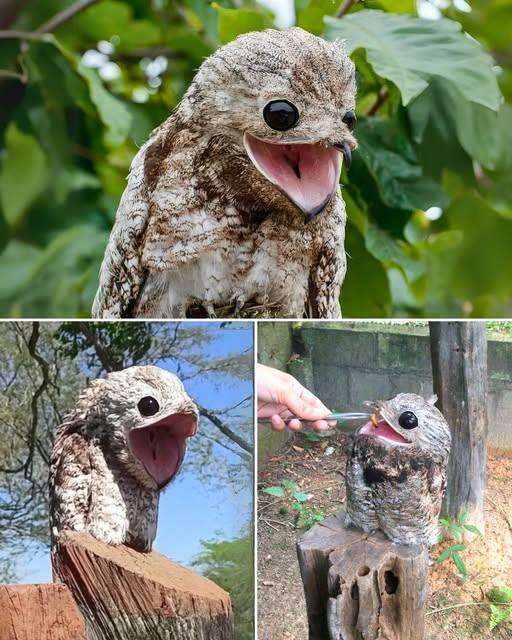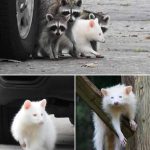The Creepiest Bird You’ve NEVER Heard Of: Meet the Great Potoo, Nature’s Master of Disguise

The Creepiest Bird You’ve NEVER Heard Of: Meet the Great Potoo, Nature’s Master of Disguise
It doesn’t scream. It doesn’t swoop. It doesn’t dazzle you with bright plumage or beg for breadcrumbs on your porch. In fact, you’ve probably never even heard of it—let alone seen it. And that’s exactly how it likes it.
Hidden in the dense forests of Central and South America, from southern Mexico to Brazil, there exists a bird so eerie, so perfectly camouflaged, and so ghost-like in its behavior that locals sometimes mistake it for a spirit. Its name? The Great Potoo (Nyctibius grandis). A name that sounds almost cartoonish—until you come face to face with its haunting, wide-eyed stare.
The Great Potoo is not your average bird. It doesn’t chirp, sing, or nest like a typical songbird. Instead, it spends its days perched high on dead tree stumps or exposed branches, absolutely motionless, mimicking a broken limb or a jagged piece of bark. And not in a half-hearted way—it becomes the branch. With its mottled gray and brown feathers, long body, and upward tilt of its beak, even trained biologists walk past it without noticing. Only when it blinks—those pale, heavy-lidded eyes sliding shut like a ghost winking—do you realize what you’re looking at.
But as the sun fades and darkness rolls over the forest, this master of disguise comes to life. In the shadows of night, the Great Potoo opens its enormous eyes—glassy and glowing in the moonlight—and takes to the skies. It doesn’t flap wildly or scream into the air. It glides. Silently. Like a whisper on wings. And it hunts—not mammals, not reptiles, but insects. Large, flying insects like beetles, moths, and grasshoppers. It waits. It watches. Then it strikes, snapping up prey mid-air with its wide, gaping mouth, which is nearly invisible when closed but stretches like a frog’s when it feeds.
It is both bird and illusion. Predator and phantom.
You might wonder: how has such a strange, almost supernatural creature gone unnoticed by the modern world? In an age where even the most remote wildlife has been memed, filmed, and turned into plush toys, the Great Potoo has managed to remain something of a secret—known mostly to birdwatchers, biologists, and indigenous storytellers.

In many local traditions, the sound of the potoo is associated with omens. And it’s no surprise. Its call is not a chirp or a melody—it is a slow, mournful, echoing “WooooooAH… woooooAH,” like the cry of something lost. Something ancient. When heard at night, especially in the remote jungle where the air is thick and the trees creak in the wind, it sounds less like a bird and more like the forest itself is grieving. Some say it cries for a lost love. Others believe it’s a soul trapped between worlds. And for those who know the sound well, it’s a strange comfort—a reminder that some mysteries still haunt the canopy.
Yet despite all this mystique, the Great Potoo is very real. Measuring about 20–24 inches in length (50–60 cm), it’s the largest of the seven potoo species, and the only one that’s truly massive enough to draw gasps when spotted. Its eyes are among the most striking in the avian world—massive, circular, and adapted to low light, giving it excellent night vision but a somewhat vacant, unsettling stare during the day.

Interestingly, the Great Potoo has evolved not to build nests. It lays a single egg directly on a flat piece of bark or the top of a broken tree, with no added material. This seems risky, but it works—the parents rely entirely on their camouflage to protect the egg. The adult takes turns guarding it by sitting motionless for hours, even days, shifting positions only slightly to adjust its balance or scan for threats. Even its blink is a calculated act: instead of fully closing its eyes, it often lowers its pale upper eyelid just enough to avoid detection, while still keeping track of its surroundings.
It’s this absolute commitment to invisibility that makes the potoo so compelling. While most birds rely on flight, color, or flocking behavior to survive, the Great Potoo’s greatest weapon is stillness. It has perfected the art of “doing nothing” to such a degree that it becomes one with its world. Watching it is like seeing camouflage come to life.

And when you think about it, that’s both awe-inspiring and a little unsettling. Because the Great Potoo reminds us that not all predators need to be fierce. Not all hunters wear claws or glare with menace. Some, like this ghostly bird, exist quietly in the margins—barely seen, barely heard, but ever-present.
In recent years, the Great Potoo has gained some viral fame online. Grainy videos of it blinking with its strange, sleepy eyes, or being gently poked by curious wildlife photographers, have circled the internet under titles like “The Weirdest Bird Ever” or “Is This Even Real?” But even these clips barely scratch the surface of its eerie charm.
To see a potoo in the wild is something else entirely.

Imagine walking through the jungle, heat rising off the forest floor, birds fluttering in the canopy, monkeys screeching in the distance. A guide stops abruptly and gestures toward a nearby tree. You squint. You see nothing but bark and branches. Then suddenly—movement. Barely perceptible. A blink. A slow turning of the head. And there it is: a living creature, perfectly disguised, watching you with those uncanny eyes.
It doesn’t fly away. It doesn’t flinch. It just watches.
It’s the kind of moment that makes you feel like you’ve wandered into an ancient story. Like you’ve stepped into a world where creatures of legend are real and hiding in plain sight.
And in many ways, that’s exactly what the Great Potoo is: a living legend. A relic from a time when nature didn’t need to shout to be heard. When silence, camouflage, and eerie cries were enough to inspire wonder and fear.

But despite its ghostly reputation, the Great Potoo is not endangered—at least, not yet. It remains fairly widespread across its range, though habitat destruction is a growing concern. As forests are cleared for agriculture or development, the very trees these birds rely on for hiding, breeding, and hunting are vanishing. And as humans push deeper into the wild, the potoo’s ancient stillness faces a modern threat.
Still, it holds on. Perched above a clearing. Watching. Waiting. Disappearing.

So the next time you find yourself deep in the forests of Central or South America, or scrolling through strange bird videos late at night, remember this odd and haunting creature. Remember the Great Potoo—not just as a “weird bird,” but as a symbol of how much we still don’t know. How much beauty hides in stillness. How many secrets still perch in plain sight, silent and unseen.
And maybe—just maybe—you’ll hear that long, echoing call in the dark.
Not a ghost. Not a dream. Just a bird, singing a sorrowful tune for a world too fast to notice.







